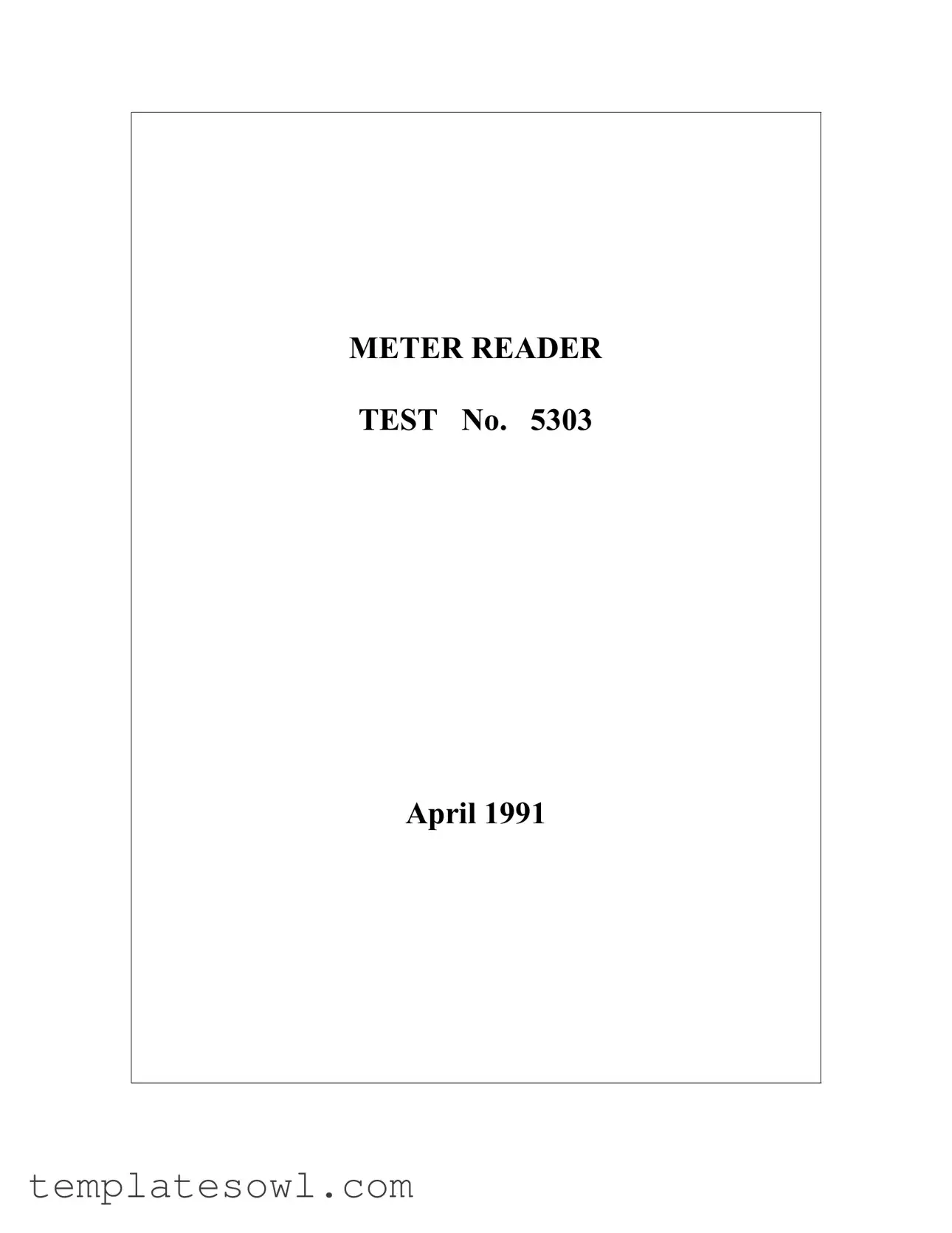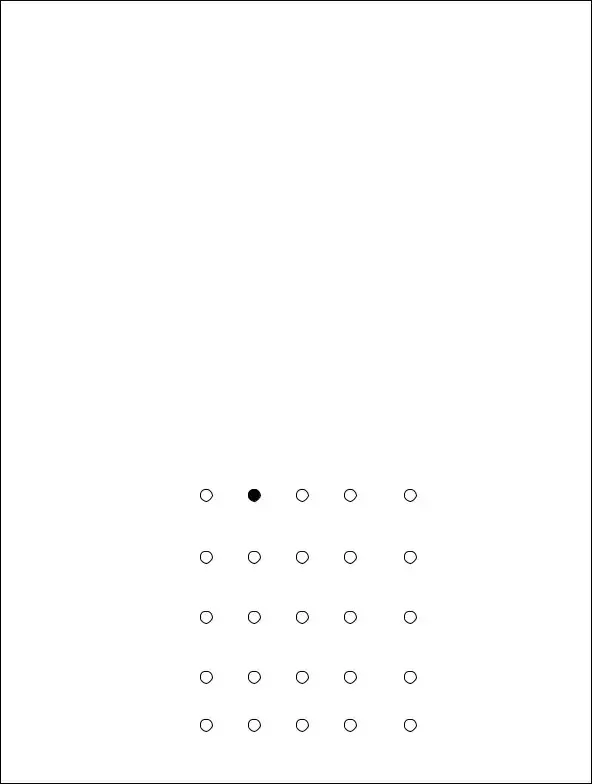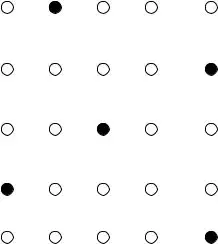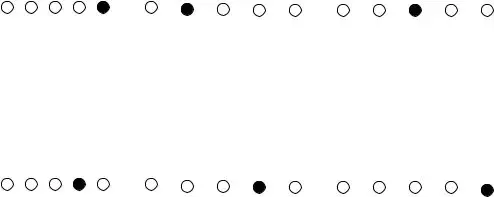METER READER TEST No. 5303
April 1991
Introduction
The purpose of this booklet is to provide information that will help to increase your confidence in taking the Meter Reader test battery. This booklet contains descriptions of the tests, sample test questions, strategies to use while taking the tests, and instructions on how to complete the answer sheets.
Why are these tests given?
Tests are used to help SCE select the most qualified people for particular jobs. Tests help to do this by providing an objective and consistent method to measure the skills and abilities of job candidates. In general, people who score higher on the tests are more likely to be successful on the job.
What types of tests are used?
The Meter Reader test battery consists of two tests: Using Tables and Coding. Each of the tests contains multiple-choice questions, which measure your basic abilities. Each test is separately timed and requires you to mark your answers on a separate answer sheet.
|
Time Limit |
Test |
(Minutes) |
Using Tables |
6 |
Coding |
5__ |
|
11 |
These test time limits MUST be strictly followed. Because the time limits on most of the tests are short, you are not expected to finish all the questions within the time allowed. Follow the directions carefully and work as quickly and accurately as you can. The actual test session will last approximately 20 minutes including instruction time.
Test-Taking Strategies
Before the test:
1.Make sure you have enough sleep the night before the test.
2.Have an adequate meal, but don’t eat too much.
3.If you ordinarily wear glasses or a hearing aid, make certain that you have them with you.
4.Make sure that you allow enough time to get to the testing location early. Be certain that you know where to go and how to get there. If you arrive after the testing session has begun, you will not be admitted for testing.
5.Read the scheduling letter very carefully. If you are instructed to bring an aid, such as a calculator, be sure it is in working order. You may also be required to bring other documents, such as a driver’s license (or other form of picture identification), a printout of DMV convictions, and/or a complete application form.
6.Practice answering the sample questions in this booklet.
During the test:
1.Be alert but calm. Try to do your best without getting tense.
2.Be sure to listen carefully to the person who gives the test directions. Read all directions very carefully. Do the sample questions even though you think you understand them.
3.Look at all the choices before you answer. Watch out for ALL OF THESE or NONE OF
THESE.
4.Try to answer all questions. Even if you are not sure of an answer, it is usually better to put down the answer you think is probably correct.
5.Answer the questions in order, but do not spend too much time on a hard one. Go on to the next one and come back to the hard ones later.
6.When you have finished the test, go back and work on any items you may have skipped.
7.Every once in a while, make certain that you are using the correct space on the answer sheet for your answer.
8.If you change an answer, be sure to erase the first answer thoroughly. If the test scanner reads both marks, it will count the answer as being wrong.
9.Do not be upset if you do not know all the answers. The tests are designed so that most examinees will not finish within the time limit.
How are the tests scored?
The points for each of tests in the battery are combined to produce an overall battery score. Your qualification is determined by the overall battery score. In other words, it is not necessary to qualify on each individual test in the battery. Therefore, you can compensate for some areas of weakness with other areas of strength. Remember, though, that the competition is stiff, so try to do your best on all the tests.
How to prepare for written tests
The list of sample questions presented in this booklet may assist in preparing for the types of test questions that you will be asked. The sections shown on the following pages contain a description of each test and several sample questions. Refer to the back of this booklet for the correct answers.
SAMPLE TEST QUESTIONS
Using Tables
This is a test of your ability to get information from tables. Look at the table shown below. This table gives the day of the month when a customer’s electric bill is due. The table is arranged by zip code (71027, 73992, 75195, 78001, and 79504) and first letter of customer’s last name.
Sample Table
First Letter |
|
|
ZIP Code |
|
|
Last Name |
71027 |
73992 |
75195 |
78001 |
79504 |
A |
05 |
13 |
04 |
25 |
11 |
B |
03 |
10 |
20 |
17 |
28 |
C |
15 |
21 |
12 |
01 |
20 |
D |
22 |
09 |
08 |
15 |
19 |
|
|
|
|
|
|
Look at the first sample problem below. To find the correct answer, look in the table at the row labeled B and the column labeled 71027. The bill due date is 03. The circle under 03 has been blackened to show this is the correct answer. Complete the four remaining problems.
Letter and
ZIP Code |
|
|
|
|
|
|
10 |
03 |
05 |
15 |
None |
1. B-71027 |
|
|
|
|
|
2. D-75195 |
09 |
12 |
19 |
18 |
None |
3. A-78001 |
08 |
17 |
25 |
11 |
None |
4. C-73992 |
21 |
12 |
10 |
02 |
None |
5. B-79504 |
03 |
11 |
17 |
27 |
None |
SAMPLE TEST QUESTIONS
Coding
Look at the sample table of codes. The sample table lists codes for Department, Department Size, and Travel Budget. Below the table are two sample problems. In the problems, darken the circles below the codes that correspond to the information found in the table.
Sample Table
Department |
Department Size |
Travel Budget |
31 |
Marketing |
1 |
1-9 employees |
A $500-999 |
25 |
Operations |
2 |
10-19 employees |
B $1,000-2,499 |
42 |
Accounting |
3 |
20-39 employees |
C $2,500-5,999 |
11 |
Research & Development 4 |
40-59 employees |
D $6,000-7,999 |
28 |
Personnel |
5 |
60 or more employees |
E $8,000-10,000 |
|
|
|
|
|
S1. Accounting Dept., staff of 10, $3,000 Travel Budget.
Department |
|
Department Size |
Travel Budget |
11 25 28 31 42 |
1 |
2 |
3 |
4 |
5 |
A B |
C D E |
S2. Marketing Dept., staff of 45, $9,500 Travel Budget.
Department |
|
Department Size |
Travel Budget |
11 25 28 31 42 |
1 |
2 |
3 |
4 |
5 |
A B |
C D E |
Be sure that you mark a code under each section of every problem.
SAMPLE TEST ANSWERS
Using Tables
This is a test of your ability to get information from tables. Look at the table shown below. This table gives the day of the month when a customer’s bill is due. The table is arranged by ZIP Code (71027, 73992, 75195, 78001, and 79504) and first letter of the customer’s last name.
Sample Table
First Letter |
|
|
ZIP Code |
|
|
Last Name |
71027 |
73992 |
75195 |
78001 |
79504 |
A |
05 |
13 |
04 |
25 |
11 |
B |
03 |
10 |
20 |
17 |
28 |
C |
15 |
21 |
12 |
01 |
20 |
D |
22 |
09 |
08 |
15 |
19 |
|
|
|
|
|
|
Look at the first sample problem below. To find the correct answer, look in the table at the row labeled B and the column labeled 71027. The bill due date is 03. The circle under 03 has been blackened to show this is the correct answer. Look at the next problem. The bill due date is 08 (row D, column 75195). The answer 08 is not shown in the problem, so NONE is marked as the correct answer. Now look at the remaining sample items. They have been answered correctly.
Letter and
ZIP Code
|
10 |
03 |
05 |
15 |
None |
1. B-71027 |
|
|
|
|
|
2. D-75195 |
09 |
12 |
19 |
18 |
None |
3. A-78001 |
08 |
17 |
25 |
11 |
None |
4. C-73992 |
21 |
12 |
10 |
02 |
None |
5. B-79504 |
03 |
11 |
17 |
27 |
None |
SAMPLE TEST ANSWERS
Coding
Look at the sample table of codes. The sample table lists codes for Department, Department Size, and Travel Budget. Below the table are two sample problems. In the problems, darken the circles below the codes that correspond to the information found in the table. Now, look at the remaining sample items. They have been answered correctly.
Sample Table
Department |
Department Size |
Travel Budget |
31 |
Marketing |
1 |
1-9 employees |
A $500-999 |
25 |
Operations |
2 |
10-19 employees |
B $1,000-2,499 |
42 |
Accounting |
3 |
20-39 employees |
C $2,500-5,999 |
11 |
Research & Development 4 |
40-59 employees |
D $6,000-7,999 |
28 |
Personnel |
5 |
60 or more employees |
E $8,000-10,000 |
|
|
|
|
|
S1. Accounting Dept., staff of 10, $3,000 Travel Budget.
Department |
|
Department Size |
Travel Budget |
11 25 28 31 42 |
1 |
2 |
3 |
4 |
5 |
A B |
C D E |
S2. Marketing Dept., staff of 45, $9,500 Travel Budget.
Department |
|
Department Size |
Travel Budget |
11 25 28 31 42 |
1 |
2 |
3 |
4 |
5 |
A B |
C D E |
It would be worthwhile to go back and look at the questions you missed. Did you understand the instructions? Did you read the questions carefully? Did you miss an important word? By checking over the questions you missed, you can help yourself to understand why you missed them. This will help you when you take that important pre- employment test for that job you want.
GOOD LUCK!





